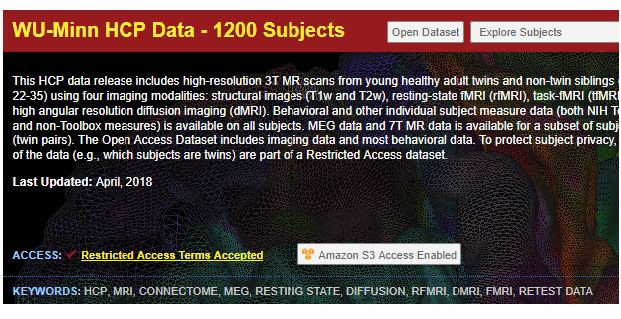HCP dMRI data download and preprocessing
This section describes how to download and process diffussion MRI (dMRI) data from the Human Connectome Project (HCP) database using various neuroconductor R packages (https://neuroconductor.org/)
HCP dMRI data download
Step 1: Obtain AWS access credential. Your AWS access credential (access key id and secret key ) is available on https://db.humanconnectome.org/app/template/Login.vm. You need tolog in your ConnectomeDB account and then click the Amazon S3 Access Enabled box. If you do not have an account, you need to first create one.

Step 2: You need to install the neurohcp R package (https://neuroconductor.org/package/neurohcp) for batch downloading from HCP database.
Step 3: You can find ID of available subjects through the hcp_1200_scanning_info function in the neurohcp package. Two functions are usually used to download data from ConnectomeDB:
-
download_hcp_dir: To download all files in a certain directory.
-
download_hcp_file: To download a certain file
library(neurohcp)
set_aws_api_key(access_key = "your_access_key", secret_key = "your_secret_key")
hcp_info=hcp_1200_scanning_info # Information of the database
hcp_id=hcp_info$id #ID of available subjects
For each subject’s dMRI directory, we can download five files (approximately, 1.3GB) as follows:
- data.nii.gz: dMRI data
- bvecs: gradient directions
- bvals: b-values
- nodif_brain_mask.nii.gz: a mask for the brain.
- grad_dev.nii.gz: effects of gradient nonlinearities on the bvals and bvecs for each voxel
# "100307" is the subject ID; an output directory should also be specified: default: tempfile()
download_hcp_dir("HCP/100307/T1w/Diffusion",verbose=FALSE, outdir="user_path")
# Downlaod the T1w image of a subject:
# - structural volume sampled at the same resolution as the diffusion data
# "100307" is the subject ID;
# - an output file path/name should also be specified: default: NULL
download_hcp_file("HCP/100307/T1w/T1w_acpc_dc_restore_1.25.nii.gz", verbose = FALSE,
destfile="user_path/out_file_name")
Notes: Sometimes, the corresponding files of an ID found through hcp_1200_scanning_info could not be downloaded through either download_hcp_dir or download_hcp_file. This problem can occur due to two reasons.
- The first is that the dMRI data of this subject have not been registered on ConnectomeDB.
- The second is that the dMRI data have not been registered with proper directory path on AWS, even though the data are available on ConnectomeDB.
You can check whether the dMRI data are available on AWS by using the hcp_list_dirs function: If the result from hcp_list_dirs does not have any value in parsed_result$Contents$Key[[1]], it means you need to check the availability of file, manually.
dir_info=hcp_list_dirs(paste0("HCP/100307/T1w/Diffusion"))
#Check whether dMRI can be downloaded thorugh the "download_hcp_dir" function.
is.null(dir_info$parsed_result$ListBucketResult$Contents$Key[[1]])
HCP dMRI data preprocessing: brain extraction and registration
The fslr R package from neuroconductor (https://neuroconductor.org/package/fslr) is needed here. Also, you need to install FSL on your computer (https://fsl.fmrib.ox.ac.uk/fsl/fslwiki/FslInstallation). The fslr package is a wrapper of FSL.
library(fslr)
Step 1 – BET extraction (https://fsl.fmrib.ox.ac.uk/fsl/fslwiki/BET): This tool deletes non-brain tissue from an image of the whole head. The resulting image is used as input for registration (Step 2).
##BET step
# input: data.nii.gz -- the original dMRI data (from "download" step)
# output: data_brain.nii.gz -- extracted brain dMRI
fsl_bet(infile="/user_path/data.nii.gz", outfile="/user_path/data_brain.nii.gz")
# input: T1w_acpc_dc_restore_1.25.nii.gz -- the original T1 image (from "download" step)
# output: T1w_brain.nii.gz -- extracted T1 image.
fsl_bet(infile="/user_path/T1w_acpc_dc_restore_1.25.nii.gz",
outfile="/user_path/T1w_brain.nii.gz")
Step 2 – FLIRT registration (https://fsl.fmrib.ox.ac.uk/fsl/fslwiki/FLIRT): This is a fully automated tool for linear (affine) intra- and inter-modal brain image registration. The brain image is registered to a template image. Both linearly and non-linearly generated MNI152 template images (whole head, extracted brain, brain mask and skull) are included in the folder /usr/local/fsl/data/standard/, courtesy of the MNI.
## Registration step
# (a) obtain transformation matrix based on T1 image registration
# input: T1w_brain.nii.gz -- extracted T1 image (from "BET" step),
# MNI152_T1_2mm_brain.nii.gz -- template image (from FSL)
# output: T1w_brain_flirt.nii.gz -- registered T1 image,
# flirt.mat -- transformation matrix
# parameter: dof=12 means affine transformation
flirt(infile="/user_path/T1w_brain.nii.gz",
outfile="/user_path/T1w_brain_flirt.nii.gz",
omat="/user_path/flirt.mat",
dof=12, reffile="/usr/local/fsl/data/standard/MNI152_T1_2mm_brain.nii.gz")
# (b) register dMRI using the registration matrix from (a)
# input: data_brain.nii.gz -- extracted dMRI (from "BET" step)
# flirt.mat -- registration transformation matrix (from (a)),
# MNI152_T1_2mm_brain.nii.gz -- template image (from FSL)
# output: data_brain_flirt.nii.gz -- registered dMRI
flirt_apply(infile="/User/data_brain.nii.gz",
outfile="/User/data_brain_flirt.nii.gz",
reffile="/usr/local/fsl/data/standard/MNI152_T1_2mm_brain.nii.gz",
initmat="/User/flirt.mat")